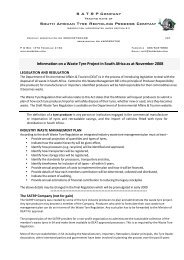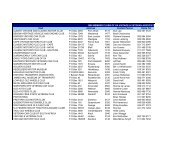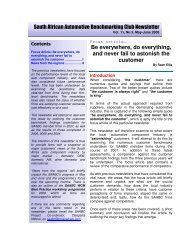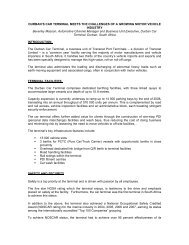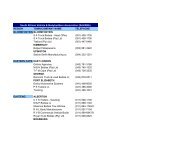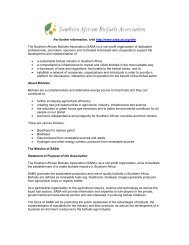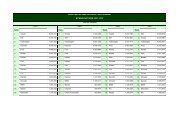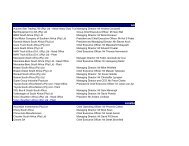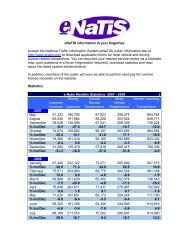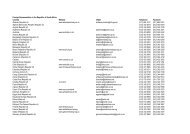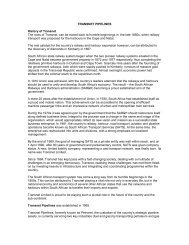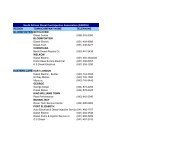Toyota South Africa Sustainability Report 2008 - Automotiveonline ...
Toyota South Africa Sustainability Report 2008 - Automotiveonline ...
Toyota South Africa Sustainability Report 2008 - Automotiveonline ...
You also want an ePaper? Increase the reach of your titles
YUMPU automatically turns print PDFs into web optimized ePapers that Google loves.
<strong>Sustainability</strong> <strong>Report</strong>_14-10-<strong>2008</strong>:Layout 1 10/14/08 2:46 PM Page 50<br />
G3 Index<br />
G3 Ref<br />
Pages<br />
G3 Ref<br />
Pages<br />
4.8 Internally developed statements of mission or values relevant to the economic,<br />
environmental and social performance of the company<br />
4.9 Procedures of the highest governance body for overseeing the organisation<br />
identification and management of economic, environmental, and social performance<br />
4.10 Processes for evaluating the highest governance body’s own performance, particularly<br />
with respect to economic, environmental, and social performance<br />
Commitments to External Initiatives<br />
4.11 Explanation of whether and how the precautionary approach or principle is addressed<br />
by the organisation<br />
4.12 Externally developed economic, environmental, and social charters, principles,<br />
or other initiatives to which the organisation subscribes or endorses<br />
4.13 Memberships in associations (such as industry associations) and/or national/<br />
international advocacy organisations<br />
Stakeholder Engagement<br />
4.14 List of stakeholder groups engaged by the organisation<br />
4.15 Basis for identification and selection of stakeholders with whom to engage<br />
4.16 Approaches to stakeholder engagement, including frequency of engagement by<br />
type and by stakeholder group<br />
4.17 Key topics and concerns that have been raised through stakeholder engagement,<br />
and how the organisation has responded to those key topics and concerns,<br />
including through its reporting<br />
5. Management Approach and Performance Indicators<br />
Economic Performance Indicators<br />
EC1<br />
EC2<br />
EC3<br />
EC4<br />
EC5<br />
Aspect: Economic Performance<br />
Direct economic value generated and distributed<br />
Financial implications and other risks and opportunities for the organisation<br />
activities due to climate change<br />
Coverage of the organisation defined benefit plan obligations<br />
Significant financial assistance received from government<br />
Aspect: Market Presence<br />
Range of ratios of standard entry level wage compared to local minimum wage at<br />
significant locations of operation<br />
5-7<br />
7-10<br />
8<br />
11<br />
IFC, 11<br />
10<br />
27<br />
27<br />
28<br />
28<br />
47-48<br />
47<br />
not<br />
available<br />
not<br />
available<br />
35<br />
EC6<br />
EC7<br />
EC8<br />
EC9<br />
Policy, practices, and proportion of spending on locally-based suppliers at significant<br />
locations of operation<br />
Procedures for local hiring and proportion of senior management hired from<br />
the local community at locations of significant operation<br />
Aspect: Indirect Economic Impacts<br />
Development and impact of infrastructure investments and services provided<br />
primarily for public benefit through commercial, in-kind, or pro bono engagement<br />
Understanding and describing significant indirect economic impacts, including the<br />
extent of impacts<br />
Environmental Performance Indicators<br />
EN1<br />
EN2<br />
EN3<br />
EN4<br />
EN5<br />
EN6<br />
EN7<br />
EN8<br />
EN9<br />
Aspect: Materials<br />
Materials used by weight or volume.<br />
Percentage of materials used that are recycled input materials.<br />
Aspect: Energy<br />
Direct energy consumption by primary energy source<br />
Indirect energy consumption by primary source<br />
Energy saved due to conservation and efficiency improvements<br />
Initiatives to provide energy-efficient or renewable energy based products and<br />
services, and reductions in energy requirements as a result of these initiatives<br />
Initiatives to reduce indirect energy consumption and reductions achieved<br />
Aspect: Water<br />
Total water withdrawal by source<br />
Water sources significantly affected by withdrawal of water<br />
EN10 Percentage and total volume of water recycled and reused<br />
Aspect: Biodiversity<br />
EN11 Location and size of land owned, leased, managed in, or adjacent to, protected areas 19<br />
and areas of high biodiversity value outside protected areas<br />
EN12 Description of significant impacts of activities, products, and services on biodiversity<br />
5, 22,39<br />
in protected areas and areas of high biodiversity value outside protected areas<br />
EN13 Habitats protected or restored<br />
19<br />
EN14 Strategies, current actions, and future plans for managing impacts on biodiversity 19<br />
not<br />
EN15 Number of IUCN Red List species and national conservation list species with habitats applicable<br />
in areas affected by operations, by level of extinction risk<br />
35<br />
42-46<br />
42<br />
data unavailable<br />
data unavailable<br />
data unavailable<br />
14<br />
data un-<br />
available<br />
14, 22<br />
14<br />
not<br />
reported<br />
17<br />
data unavailable<br />
19<br />
50



